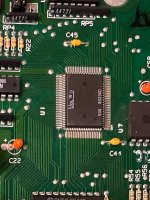modem7
10k Member
I asked that, because if you do, you could see what the procedure at [here] reveals.Do you have the ability to ground a pin in an ISA slot (connect it to ground) ?
- Substitute 'V20' where you read '8088'.
-For step 1, you can use Ruud's Diagnostic ROM, because it has the byte of EAh at the required location.
-For step 2, you will need to ground pin A10 of an ISA slot.
-For steps 5, 6, and 7, you will need to cater for the fact that you are using a different type of ROM.

